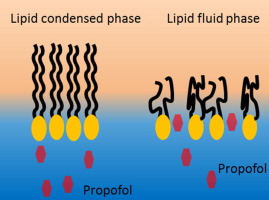Journal of Colloid and Interface Science ( IF 9.9 ) Pub Date : 2018-03-15 , DOI: 10.1016/j.jcis.2018.03.052 Petru Niga , Petra M. Hansson-Mille , Agne Swerin , Per M. Claesson , Joachim Schoelkopf , Patrick A.C. Gane , Erik Bergendal , Andrea Tummino , Richard A. Campbell , C. Magnus Johnson

|
Vibrational sum frequency spectroscopy (VSFS) complemented by surface pressure isotherm and neutron reflectometry (NR) experiments were employed to investigate the interactions between propofol, a small amphiphilic molecule that currently is the most common general anaesthetic drug, and phospholipid monolayers. A series of biologically relevant saturated phospholipids of varying chain length from C18 to C14 were spread on either pure water or propofol (2,6-bis(1-methylethyl)phenol) solution in a Langmuir trough, and the change in the molecular structure of the film, induced by the interaction with propofol, was studied with respect to the surface pressure. The results from the surface pressure isotherm experiments revealed that propofol, as long as it remains at the interface, enhances the fluidity of the phospholipid monolayer. The VSF spectra demonstrate that for each phospholipid the amount of propofol in the monolayer region decreases with increasing surface pressure. Such squeeze out is in contrast to the enhanced interactions that can be exhibited by more complex amphiphilic molecules such as peptides. At surface pressures of 22–25 mN m−1, which are relevant for biological cell membranes, most of the propofol has been expelled from the monolayer, especially in the case of the C16 and C18 phospholipids that adopt a liquid condensed phase packing of its alkyl tails. At lower surface pressures of 5 mN m−1, the effect of propofol on the structure of the alkyl tails is enhanced when the phospholipids are present in a liquid expanded phase. Specifically, for the C16 phospholipid, NR data reveal that propofol is located exclusively in the head group region, which is rationalized in the context of previous studies. The results imply a non-homogeneous distribution of propofol in the plane of real cell membranes, which is an inference that requires urgent testing and may help to explain why such low concentration of the drug are required to induce general anaesthesia.
中文翻译:

模型细胞膜与神经活性药物丙泊酚之间的相互作用
振动和频光谱法(VSFS)以及表面压力等温线和中子反射法(NR)实验的补充,用于研究异丙酚(一种目前是最常见的全身麻醉药的两亲小分子)与磷脂单层之间的相互作用。一系列从C 18到C 14链长不同的生物学相关的饱和磷脂将其涂在Langmuir槽中的纯水或丙泊酚(2,6-双(1-甲基乙基)苯酚)溶液上,并研究了与丙泊酚相互作用引起的薄膜分子结构变化表面压力。表面压力等温线实验的结果表明,只要异丙酚保留在界面上,丙泊酚就会提高磷脂单层的流动性。VSF光谱表明,对于每个磷脂,单分子层区域中丙泊酚的量随表面压力的增加而减少。这种挤出与更复杂的两亲分子(如肽)所表现出的增强的相互作用相反。在22–25 mN m -1的表面压力下与生物细胞膜有关,大多数异丙酚已从单层排出,尤其是在C 16和C 18磷脂的烷基尾部采用液态冷凝相填充的情况下。在5 mN m -1的较低表面压力下,当磷脂存在于液体膨胀相中时,丙泊酚对烷基尾巴结构的影响会增强。具体来说,对于C 16磷脂,NR数据显示丙泊酚仅位于头基区域,这在先前研究的背景下是合理的。结果暗示了丙泊酚在真实细胞膜平面内的不均匀分布,这是一个需要紧急测试的推论,可能有助于解释为什么需要如此低的药物浓度来诱导全身麻醉。


























 京公网安备 11010802027423号
京公网安备 11010802027423号